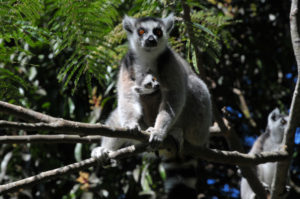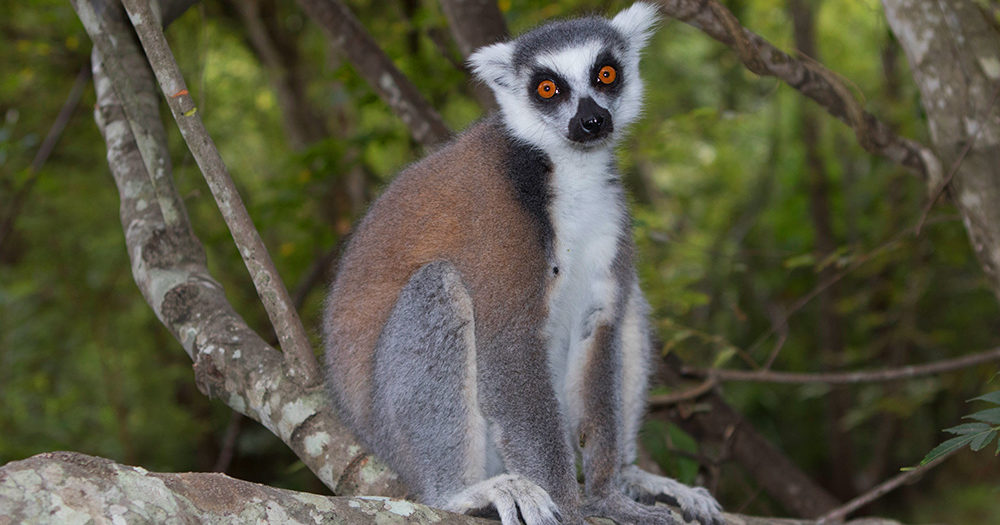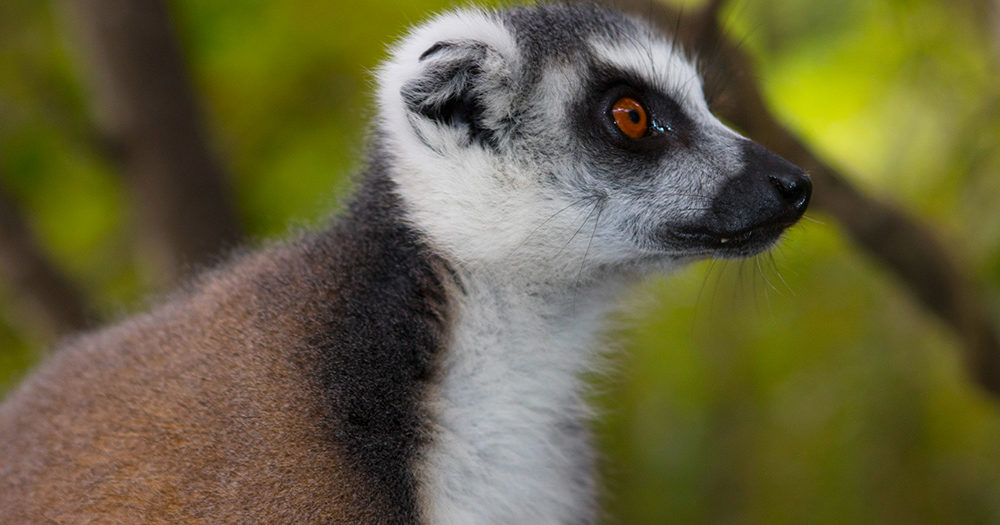They are the unofficial mascots of Madagascar and probably the most famous Malagasy lemurs: The ring-tailed lemurs (Lemur catta). Their portraits grace the logo of Madagascar National Parks (MNP), countless t-shirts, and company emblems. A full-grown ring-tailed lemur weighs maximally 3.5 kg. The ringed tail is 60 cm longer than the whole body which is only 40-45 cm. In contrast to many other lemurs of Madagascar, for example, the Indri, ring-tailed lemurs are enormously adaptable. That is why they have been kept and bred in zoos worldwide successfully for decades. With their characteristic black and white tail and the black eye mask, they soon became darlings of the public. Accordingly, ring-tailed lemurs are among the best-researched lemurs of Madagascar. And with this researches, a lot of curiosities have been uncovered.

Scientists today know, for example, that the tail of these lemurs always has 13 to 15 stripes. Male ring-tailed lemurs have a penis bone just like dogs, gorillas, and walruses – by the way, humans do not have one. Even females have a smaller clitoris bone. Ring-tailed lemurs spend one-third of the day walking on the ground. This is very extraordinary for a lemur species since most lemurs avoid touching the ground under any circumstances. Especially communication among ring-tailed lemurs has been a focus of research. Scientists know more than 25 different calls and sounds. The lemurs purr like cats if they like something and bark like dogs when they want to threaten someone. Males can even threaten others with the smell of their stink glands. In zoos, the oldest ring-tailed lemur reached the age of 27 years, while its relative in the wilderness only become half that old.
In Madagascar, you do not only find ring-tailed lemurs in zoos but mainly in their natural habitat. They inhabit the dry areas of the southwest. In the west, their distribution range is limited by Mangoky river and the city Belo sur Mer, the northern limits are the foothills of the Andringitra mountains near Ambalavao. In the south, they occur in Andohahela, Isalo, Tsimanampetsotsa and Zombitse-Vohibasia until Tolagnaro (earlier Fort Dauphin). Most of these areas consist of dry and spiny forests as well as savannahs. The rainy season is short there, and during all other months, the climate is rather dry and hot. Only the populations in Andringitra Mountains and Anja Community Reserve have a moderate climate with more rain, but also much lower temperatures. The populations are widely scattered and isolated from each other, so the IUCN list them as “endangered” on the red list of threatened species.

Ring-tailed lemurs live in family troops of six to fifteen individuals and have a matriarchy which means the females lead the group. Males are the ones of the group who have to leave at the age of three to five years. Together with other bachelors, they try to join another group or found their own. In April which is the end of the rainy season, the males fight for better ranks in the hierarchy – and thus for the best mating chances. Females are ready to mate for only one day – if you want to be successful here, you will have to watch carefully to find the perfect time. But the females choose their partners on their own. It is not rare for them to mate with several different males. Gravidity takes four and a half months and passes the dry season. It is not before the again coming rainy season from September on that the young are born. Most females bear a single young, but twins occur from time to time. Only a third of them reach adulthood.
At the age of five months, the young ring-tailed lemurs are weaned. Their diet widens from day to day until they eat everything their older family members eat, too. Ring-tailed lemurs are no picky eaters. They favor fruits which of course are mainly available during the rainy season. But the diet is extended with flowers, leaves, and insects. And if a too slow chameleon crosses their path, they will not despise it.

Tamarinds and opuntia are among the most eaten plants. Ring-tailed lemurs have a strict daily routine: In the morning and in the afternoon, they forage in trees and on the ground. During the midday heat, the lemurs usually sleep or rest. In the morning, you can watch behavior that has become famous worldwide: The ring-tailed lemurs sit cross-legged, the hands on the knees, the belly directed to the sun. This “meditation” position serves the purpose of warming up quicker – indeed ring-tailed lemurs enjoy the first warming sun rays of the day. Ring-tailed lemurs are not strictly territorial but have preferred home ranges. They often share these ranges with Verreaux’ sifakas, sportive lemurs, and fat-tailed dwarf lemurs. Throughout the day, ring-tailed lemurs slowly roam from one feeding ground to the next, covering about one kilometer a day.

Most people think ring-tailed lemurs are absolutely cute. Sometimes, this can become fatal for this species: Poachers steal young ring-tailed lemurs from their mothers to sell them as pets. Those are kept in huts or small cages. Often, these poor creatures are used to be shown around among tourists who love to pose for a picture with a ring-tailed lemur on their shoulders. The majority of these “pets” do not get proper care or correct nutrition and are usually kept alone although highly social. In the end, this leads to diseases and early death of the animals. Some Malagasy organizations try to stop this illegal behavior. Information platforms ask travelers to stop booking hotels or restaurants keeping such “pets” and to avoid taking pictures with ring-tailed lemurs that obviously do not live in a natural habitat. They also care for the confiscation of illegally kept lemurs in Madagascar. Up to date, there is only one reserve in Madagascar who accommodates confiscated lemurs to make them ready for getting back into wilderness again: Reniala in Ifaty-Mangily at the southwest coast. Some people also hunt ring-tailed lemurs for food and sell the meat secretly on markets or to restaurants. Another threat for the species is ongoing slash-and-burn agriculture to gain acres and zebu pastures.
If you want to experience ring-tailed lemurs in the wild, you will have the best chances in national park Isalo, Anja Community Reserve or Berenty reserve. These are the places where you can find them all around the year playing, foraging, and communicating. The best season to watch ring-tailed lemurs is probably around October and November, because this is the time for the young lemurs to start exploring their environment.
 MADAMAGAZINE Your Magazine about Madagascar
MADAMAGAZINE Your Magazine about Madagascar













